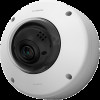Canon VB-H651VE User Manual - Page 178
[Event] > [Intelligent Function] - Video Detection -, Steps for Configuring Video Detection
 |
View all Canon VB-H651VE manuals
Add to My Manuals
Save this manual to your list of manuals |
Page 178 highlights
[Event] > [Intelligent Function] - Video Detection - In video detection, select the type to detect, and set the tracking area for video changes while checking images on the camera. You should also set which operations (e-mail notification, record video, playing audio from the speaker connected to the camera) should be carried out when changes are detected. The following settings can be configured here. • Operation Mode • Detection Settings (List) • Non-detection Area Settings (List) • Display Options • Camera Position Settings • Detection Settings (Details) • Non-detection Area Settings (Details) Steps for Configuring Video Detection Set an area where changes in video are detected and an area where changes in video are not detected (non-detection area) as necessary. Configuring the Detection Area The following are the basic steps for configuring a detection area. For details on settings for each type of detection, please refer to "Configuring Detection Criteria ([Detection Criteria] Tab)" (P. 182). 1 Select [Lock camera position] in [Camera Position Settings], then select a preset. R13 R12 M50 H761 H760 For details on how to adjust presets, please refer to "[Camera] > [Preset] Registering Presets" (P. 132). Note You can select presets that meet the following conditions. - Presets configured within the view restrictions - Presets with pan, tilt and zoom setting values (not blank) configured in [Preset Registration] (P. 134) R13 R12 M50 - Presets with zoom setting values (not blank) configured in [Preset Registration] (P. 134) H761 H760 178















